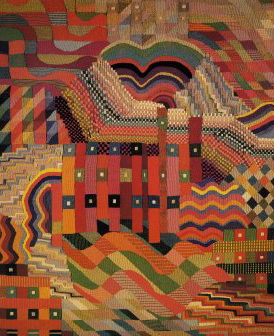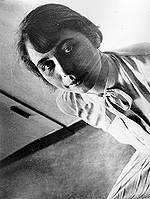Gunta Stölzl, Slit Tapestry Red/Green, 1927/28
Cotton, silk, linen 150 x 110cm
Gunta Stölzl, an innovative and influential textile designer, began as a student at the Bauhaus in 1919 and was named the only female Bauhaus Master in 1927—by which time she had made the Weaving Workshop the most profitable workshop at the Bauhaus.
In a letter to the Museum of Modern Art when they acquired her piece Wandbehang Schwarz-Weiss, Stölzl wrote:
The Bauhaus period was, for all of us, like a chamber of unalienable pleasures.
Born in Munich in 1897, Stölzl studied painting, ceramics and art history at the Kunstgewerbeschule (School of Arts & Crafts) in Munich from 1913-16. After serving as a Red Cross nurse from 1917-18 during World War I, Stölzl became aware of the Bauhaus, which was founded by Walter Gropius in Weimar in 1919. Like many of the female students, Stölzl was an accomplished visual artist attracted to the Bauhaus by the presence of painters Wassily Kandinsky, Paul Klee, Johannes Itten, Josef Albers, Lyonel Feininger and others.
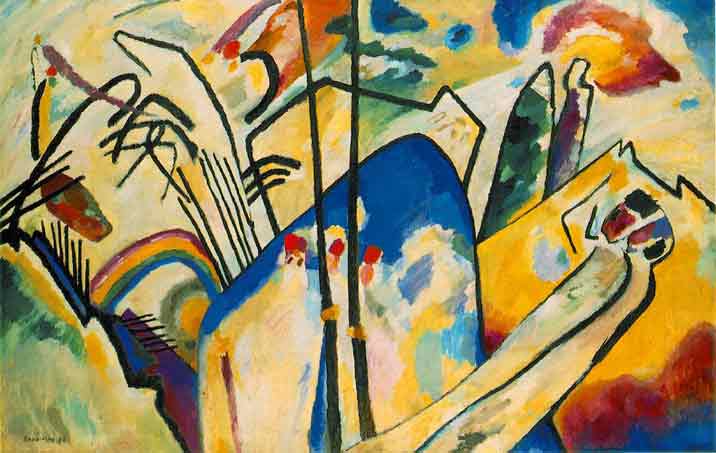 Wassily Kandinsky, Composition IV, 1919
Wassily Kandinsky, Composition IV, 1919
Kunstsammlung Nordrhein-Westfalen, Dusseldorf
In the spring of 1920, Stölzl was accepted on a trial basis to the Bauhaus and enrolled in Johannes Itten’s Vorkurs (preliminary course).
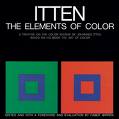 Johannes Itten, The Elements of Color
Johannes Itten, The Elements of Color
By the fall of that year she was awarded a full scholarship. Walter Gropius assigned painters to lead the workshops instead of craftsmen, which was in line with his ideas about elevating craft to the level of fine art, an approach that was very effective in attracting visually sophisticated students. The fundamental approach of the Bauhaus was to see things with fresh eyes, to discard old notions. Paul Klee called this approach “visual thinking.”
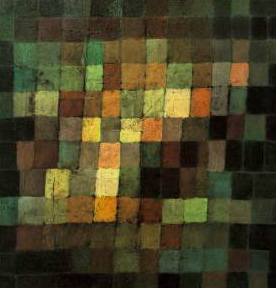 Paul Klee, Ancient Sound, Abstract on Black, 1925
Paul Klee, Ancient Sound, Abstract on Black, 1925
Oil on cardboard, 15″ x 15″
Kunstsammlung, Basel
This approach also contributed to a lot of collaboration and cross-pollination of visual ideas.
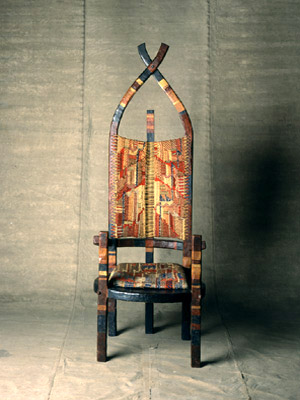 Gunta Stölzl and Marcel Breuer, African Chair, 1921
Gunta Stölzl and Marcel Breuer, African Chair, 1921
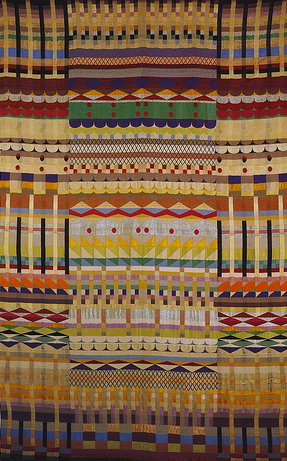 Gunta Stölzl, 5 Chöre (5 Choirs), 1928
Gunta Stölzl, 5 Chöre (5 Choirs), 1928
Jacquard wall hanging Cotton, wool, rayon and silk
229 x 143 cm
Museum für Kunst und Kulturgeschichte, Lübeck
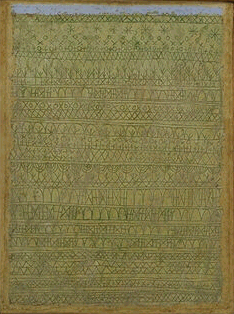 Paul Klee, Pastoral, 1927
Paul Klee, Pastoral, 1927
Tempera on canvas, mounted on wood, 69.3 x 52.4 cm
Museum of Modern Art, NY.
Gropius had founded the Bauhaus on the principle of Gesamtkunstwerk (total work of art), where design, visual aesthetics and mastery of technique would come together. The admission policy espoused gender equality, but the reality was very different. Gropius was taken aback by how many women applied to the Bauhaus and quickly established a “Women’s Department” to channel the female students into the Weaving, Bookbinding and Pottery Workshops—and, with few exceptions, such as Florence Henri, this was what transpired. As it turned out, Gerhard Marcks, the head of the Pottery Workshop, did not want women in his department and the Bookbinding Workshop shut down in 1922. The result was that the Weaving Workshop soon remained the sole option for many female Bauhaus students, who only had access to painting classes via the Weaving Workshop.
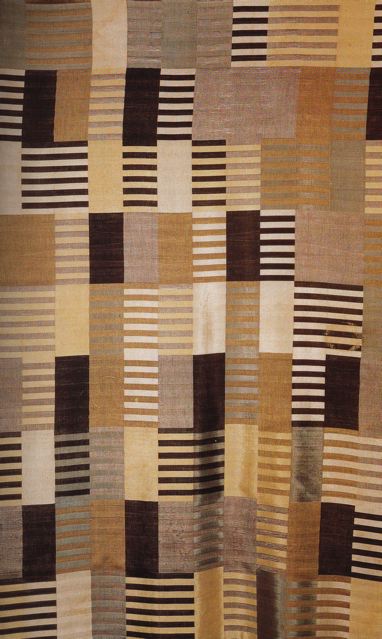 Anni Albers, Wall hanging, triple-weave, 1926
Anni Albers, Wall hanging, triple-weave, 1926
When Gunta Stölzl joined the Weaving Workshop, it was languishing under the leadership of Georg Muche, the master of the Weaving Workshop from 1921-27, and Helene Börner—neither of whom had the skills to help the students advance their technique. Börner, who provided all the looms and equipment for the Weaving Workshop, had been trained as a Handarbeitslehrerin (home economics teacher) which garnered her little respect among the students. Stölzl soon took over the technical direction of the workshop. She was a person of tremendous enthusiasm and energy and she quickly understood the equipment and grasped the possibilities of weaving. She had an instinctive feel for the process, was passionate about experimenting with new materials and constantly explored new ideas in color and design and their applications for industrial design. In 1922 Stölzl studied dyeing techniques in Krefeld with fellow Bauhaus weaver Benita Otte and on their return established a dye facility at the Bauhaus. One of Stölzl’s students, Anni Albers, often said that Stölzl was an excellent teacher, “having almost an animal feeling for textiles.” Stölzl was appointed craft master of the Weaving Workshop in Dessau in 1925.
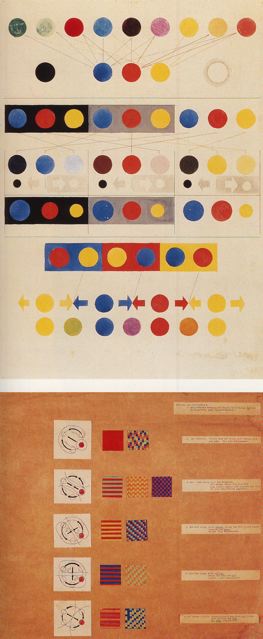 Benita Otte, Color studies, c.1925
Benita Otte, Color studies, c.1925
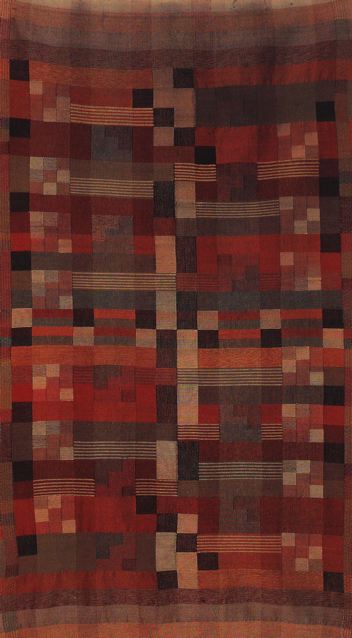 Benita Otte,Wall hanging, 1923
Benita Otte,Wall hanging, 1923
Shown in Bauhaus Exhibition, Haus am Horn
In spite of the limitations placed on female students at the Bauhaus, many flourished there, particularly in the Weaving Workshop. At that time, women were often barred from traditional art academies, and, adapted to low expectations, found the Bauhaus relatively inclusive and the atmosphere exciting and inspiring. Stölzl, who was always pleased to talk about her days at the Bauhaus, later wrote about that time:
I believe that the most important of all was life itself. It was brimful with impressions, experiences, encounters and friendships which have lasted over decades.
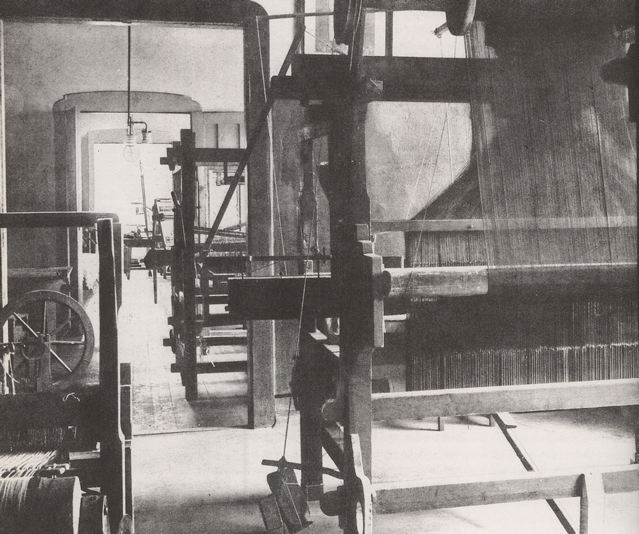 Weaving Workshop at the Bauhaus, Weimar
Weaving Workshop at the Bauhaus, Weimar
Stölzl was inspired by Paul Klee’s passion for color and form and Kandinsky’s ideas about abstraction. Kandinsky wrote in Concerning the Spiritual in Art:
The more abstract is form, the more clear and direct its appeal…The more an artist uses these abstracted forms, the deeper and more confidently will he advance into the kingdom of the abstract.
Exploring these principles, Stölzl guided the Weaving Workshop from personal, pictorial and decorative tapestry weaving to the production of innovative, abstract and geometric textiles for domestic and industrial use. In accordance with Bauhaus philosophy, textiles as art or a means of personal expression was discouraged, utility and simplicity were valued. Stölzl’s creative energies were devoted to developing new weave structures, the innovative use of synthetic fibers and exploring new dyeing techniques.
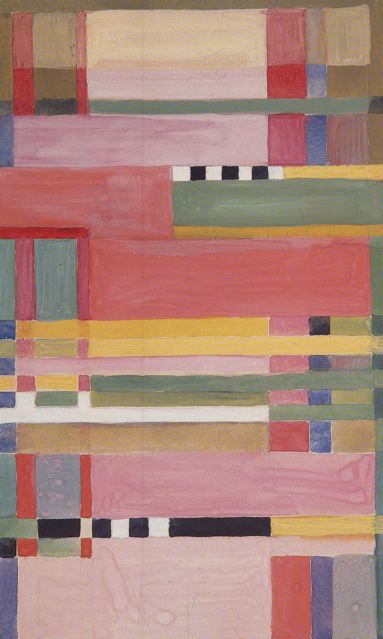 Gunta Stölzl, Design for rug, 1926
Gunta Stölzl, Design for rug, 1926
Gouache on paper
In The Development of the Bauhaus Weaving Workshop, 1931, Stölzl said this about the Weimar years:
Gradually a change took place. We began to sense how pretentious these independent, unique pieces were: tablecloths, curtains, wall coverings. The richness of colour and form became too licentious for us; it did not adapt itself, it did not subordinate itself to living. We tried to become more simple, to discipline our means, to use these in a more straightforward and functional way. Thus we came to yard goods which could directly serve the room, the living problem. The watchword of the new epoch was models for industry.
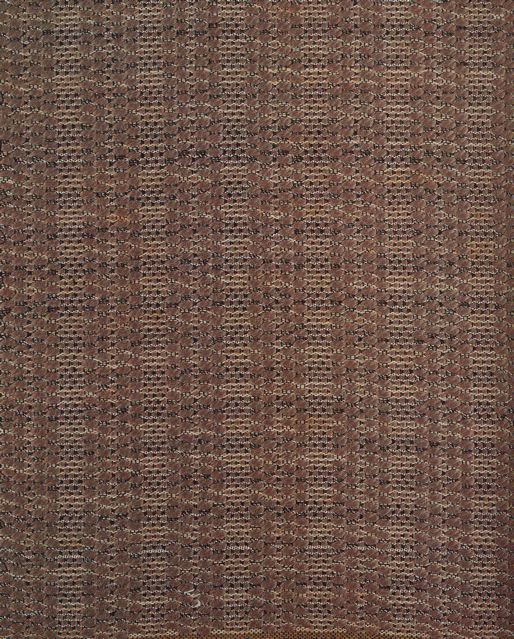 Gunta Stölzl, Upholstery fabric, c. 1925-30
Gunta Stölzl, Upholstery fabric, c. 1925-30
For political reasons, Stölzl resigned from the Bauhaus in 1931 and moved to Switzerland where she founded a hand-weaving workshop in Zürich which she ran in one form or another until 1967. At that time Stölzl disbanded the workshop, resumed tapestry weaving and pursued her own work until her death in 1983. Unfortunately many of the pieces she produced during the Bauhaus period are lost, but enough remain to assure her legacy. In 1976 she was given a solo show at the Bauhaus-Archive in Berlin and her work has been included in many retrospective shows about the Bauhaus.The Museum of Modern Art in New York mounted the exhibition, Gunta Stölzl and Anni Albers, in 1990. The curator of the exhibition, Matilda McQuaid wrote:
The textile designs of Gunta Stölzl and Anni Albers are creative experiments in material, structure and color. Rejecting a nineteenth-century tradition of cloth-making that emphasized pictorial imagery, Stölzl and Albers altered the course of twentieth-century weaving by introducing new fibers and finishes and by revealing the fundamental woven structure, or the warp and weft, of the cloth.
A book about Stölzl’s life and work, with text and forward by her daughter, Monika Stadler, Gunta Stölzl: Bauhaus Master, has recently been published by The Museum of Modern Art. Also recommended reading: Women’s Work: Textile Art from the Bauhaus by Sigrid Wortmann Weltge.
Stölzl’s work can be seen in the upcoming exhibit at the Museum of Modern Art, Bauhaus 1919-1933: Workshops for Modernity, November 8, 2009-January 25, 2010. An accompanying monograph, Bauhaus Women: Art, Handicraft, Design by Ulrike Miller, will be available in November 2009.
